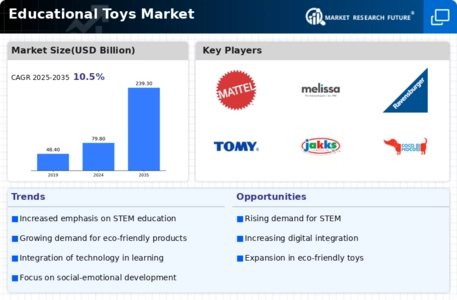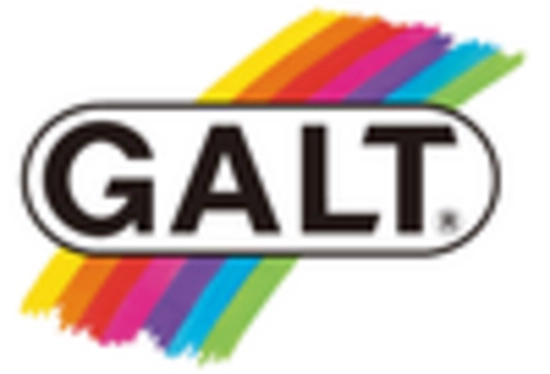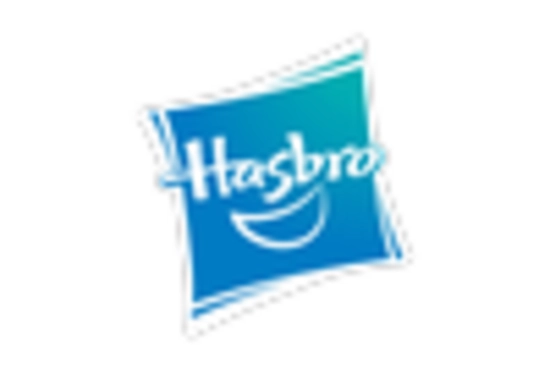Market Trends
Key Emerging Trends in the Educational Toys Market
High-tech educational toys that are connected to the internet are gaining popularity among a growing number of tech-savvy consumers. A smart toy has its own intelligence and is powered by on-board electronics and embedded sensors. Because of their specialized instructional approach and ease of use, smart toys are preferred above conventional learning toys, even with their high price tag. Over the course of the projection period, there is expected to be a significant global demand for Science, Technology, Engineering, and Math (STEM) toys due to the growing adoption of these smart toys. STEM toys are made to encourage children's creativity and problem-solving abilities in an entertaining and captivating way.
The educational toys market has undergone significant transformations driven by shifts in parenting philosophies, technological advancements, and a growing emphasis on early childhood development. One noteworthy trend is the integration of technology into educational toys, offering interactive and engaging learning experiences for children. Smart educational toys often incorporate features such as touchscreens, sensors, and connectivity to enhance cognitive skills, problem-solving abilities, and creativity. This technological trend aligns with the increasing prevalence of digital devices in daily life, providing children with interactive and dynamic educational tools.
Sustainability has emerged as a prominent trend in the educational toys market, reflecting a broader societal awareness of environmental concerns. Manufacturers are incorporating eco-friendly materials, such as recycled plastics or sustainably sourced wood, into the production of educational toys. Additionally, there is a growing emphasis on packaging sustainability, with brands opting for recyclable and minimalistic packaging. This trend responds to the demand from environmentally conscious parents who seek toys that align with their values and contribute to a more sustainable future.
The rise of STEAM (Science, Technology, Engineering, Arts, and Mathematics) education has influenced the educational toys market, leading to the development of toys that specifically target these core areas of learning. STEAM-focused toys encourage hands-on exploration and experimentation, fostering skills in problem-solving, critical thinking, and creativity. This trend reflects a broader recognition of the importance of preparing children for a future that requires proficiency in these key disciplines.
The diversity and inclusivity trend has impacted the design and content of educational toys, with a focus on representation and cultural sensitivity. Manufacturers are developing toys that feature characters from diverse backgrounds, address various learning styles, and incorporate inclusive narratives. This trend acknowledges the diverse identities of children and aims to create an inclusive learning environment that resonates with a wide range of families.
Collaborations between educational toy manufacturers and popular media franchises have become prevalent, leading to the creation of toys inspired by beloved characters from children's books, TV shows, and movies. These licensed educational toys leverage familiar characters to make learning more engaging and relatable for children. The collaboration trend recognizes the influence of media and popular culture on children's interests and preferences, incorporating entertainment elements into educational play.
Educational subscription services have gained popularity as a trend in the market, providing parents with a curated selection of educational toys delivered regularly to their doorstep. These subscription boxes often include age-appropriate toys, books, and activities designed to support specific learning milestones. The subscription model offers convenience to parents, introducing them to a variety of educational resources while catering to their child's developmental stage. This trend aligns with the desire for hassle-free access to educational materials in a rapidly changing market.
The impact of the COVID-19 pandemic has accelerated the adoption of e-learning and remote education, influencing trends in the educational toys market. Parents seeking supplementary educational resources for home-based learning have turned to educational toys that complement virtual classrooms. STEM kits, coding toys, and educational games have become particularly popular, providing children with interactive learning experiences while at home. This pandemic-driven trend underscores the adaptability of the educational toys market to meet the evolving needs of families during unprecedented times.
Educational toys designed to enhance social and emotional learning (SEL) skills have gained recognition as an important trend. These toys focus on fostering skills such as empathy, communication, and relationship-building, addressing the holistic development of children. SEL-focused toys often include scenarios and activities that encourage emotional intelligence, helping children navigate social interactions and understand their own emotions. This trend reflects a growing awareness of the significance of social and emotional development in early childhood education.
Augmented reality (AR) and virtual reality (VR) technologies have found their way into educational toys, offering immersive and interactive learning experiences. AR and VR educational toys provide children with virtual environments where they can explore, learn, and engage with educational content. This technological trend adds a layer of excitement to learning, capturing the attention and curiosity of young learners in a digital age.
Open-ended and flexible educational toys have gained popularity, encouraging creativity, imagination, and independent play. These toys, such as building blocks, art supplies, and construction sets, allow children to explore and create without predefined rules or outcomes. The trend towards open-ended play recognizes the importance of fostering creativity and problem-solving skills, providing children with the freedom to express themselves and develop a sense of autonomy.
Educational toys designed for specific developmental milestones have become a focus within the market. Manufacturers are creating toys that target cognitive, motor, and language development at different stages of a child's growth. This trend aligns with the understanding that children progress through various developmental milestones, and age-appropriate toys can support and enhance their learning experiences accordingly.

















Leave a Comment